The respiration monitor belt market is poised to expand from USD 226.9 million in 2025 to USD 1,260.1 million by 2035, reflecting a CAGR of 18.7%. The growth rate volatility index indicates moderate fluctuations during the decade due to shifts in adoption across healthcare facilities, wearable medical devices, and home monitoring applications. Early in the period, 2025 to 2027, growth accelerates rapidly as hospitals, sleep clinics, and fitness technology providers adopt respiration monitor belts for patient monitoring, sleep apnea detection, and wellness tracking. Technological innovations such as wireless connectivity, real-time data transmission, and integration with mobile health applications amplify adoption, contributing to higher volatility during this initial phase.
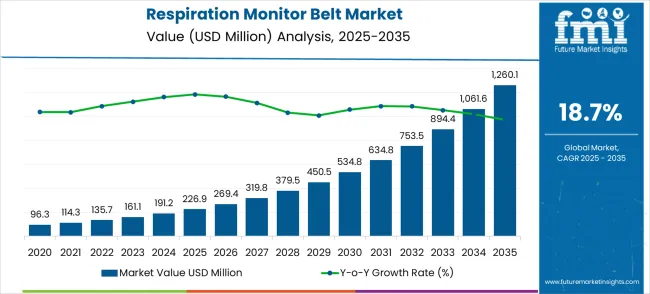
Between 2028 and 2032, the growth rate stabilizes as the market sees wider penetration and technology standardization. Manufacturers focus on improving sensor accuracy, comfort, and battery life, which sustains adoption while reducing abrupt shifts in demand. From 2032 to 2035, growth accelerates again, driven by rising demand in home healthcare, telemedicine, and aging population segments requiring continuous respiratory monitoring. Expansion in emerging economies further smooths volatility by adding consistent demand sources. The volatility index reflects a market with alternating rapid adoption and stabilization phases, emphasizing opportunities for companies to strategically plan production, R&D investments, and distribution to capture high-growth periods while maintaining resilience during moderate fluctuation phases.
The respiration monitor belt market is segmented into hospitals and clinical settings (42%), home healthcare (27%), sleep disorder clinics (15%), sports and fitness monitoring (10%), and specialty research applications (6%). Hospitals lead adoption as these belts provide continuous, non-invasive monitoring of patient respiratory rates, assisting in critical care and post-operative recovery. Home healthcare increasingly uses them for remote monitoring of chronic respiratory conditions. Sleep disorder clinics deploy these devices for apnea and insomnia studies. Sports and fitness sectors adopt belts for real-time respiratory tracking to optimize performance. Specialty applications include physiological research and clinical trials requiring accurate and continuous respiratory data.
Trends in the market include integration with wireless connectivity, wearable sensors, and cloud-based health monitoring platforms for real-time data collection. Manufacturers are innovating with flexible, lightweight, and washable belts for comfort during prolonged use. Adoption is expanding in telemedicine, fitness tracking, and remote patient monitoring. Collaborations between device makers, hospitals, and research institutions enable customized solutions for diverse patient populations. Focus on accuracy, patient comfort, and data-driven healthcare insights continues to drive global market growth.
| Metric | Value |
|---|---|
| Market Value (2025) | USD 226.9 million |
| Market Forecast Value (2035) | USD 1,260.1 million |
| Forecast CAGR (2025–2035) | 18.7% |
Market expansion is being supported by the rapid adoption of digital health technologies across healthcare systems and consumer markets and the corresponding need for continuous physiological monitoring solutions that provide real-time respiratory data for health assessment and disease management. Modern healthcare delivery requires sophisticated monitoring technologies that can provide accurate respiratory measurements, early warning indicators, and comprehensive health data integration while maintaining user comfort and compliance. The superior measurement accuracy and user-friendly characteristics of respiration monitor belts make them essential components in preventive healthcare systems where continuous monitoring and early intervention capabilities are critical for improved health outcomes.
The growing focus on preventive healthcare and chronic disease management is driving demand for wearable monitoring technologies from certified manufacturers with proven track records of accuracy and reliability in clinical applications. Healthcare providers and consumers are increasingly investing in respiration monitoring systems that offer continuous data collection capabilities while enabling real-time health assessment and automated alert functionalities. Regulatory requirements and healthcare standards are establishing performance benchmarks that favor advanced wearable monitoring solutions with validated accuracy and seamless integration capabilities.
The market is segmented by detector type, application, and region. By detector type, the market is divided into chest strap breathing detector, nose clip breathing detector, and ear clip breathing detector configurations. Based on application, the market is categorized into smart sports and smart healthcare segments. Regionally, the market is divided into North America, Europe, East Asia, South Asia & Pacific, Latin America, and Middle East & Africa.
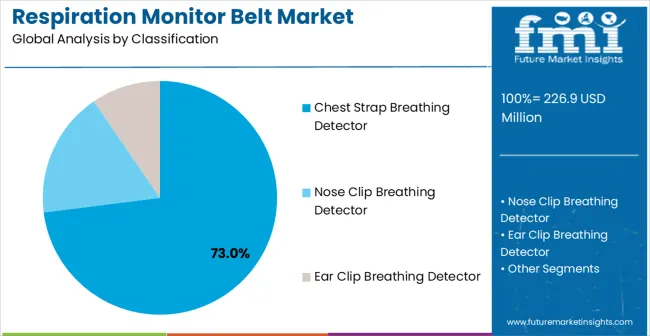
Chest strap breathing detector configurations are projected to account for 73% of the respiration monitor belt market in 2025. This leading share is supported by the excellent measurement accuracy, comfort characteristics, and comprehensive monitoring capabilities that chest strap systems offer for diverse healthcare and sports applications. Chest strap breathing detectors provide continuous respiratory rate monitoring with high accuracy and minimal user discomfort, making them the preferred choice for clinical monitoring, fitness tracking, sleep studies, and chronic disease management applications. The segment benefits from technological advancements that have improved sensor sensitivity, reduced device size, and enhanced wireless connectivity features.
Modern chest strap breathing detectors incorporate advanced strain gauge technologies, sophisticated signal processing algorithms, and intelligent motion artifact rejection systems that deliver exceptional measurement accuracy while maintaining user comfort during extended monitoring periods. These innovations have significantly improved monitoring reliability while maintaining compatibility with various mobile health platforms and reducing false readings through advanced filtering and calibration capabilities. The healthcare sector particularly drives demand for chest strap solutions, as medical professionals require reliable monitoring systems that can provide accurate respiratory data for clinical assessment and patient management.
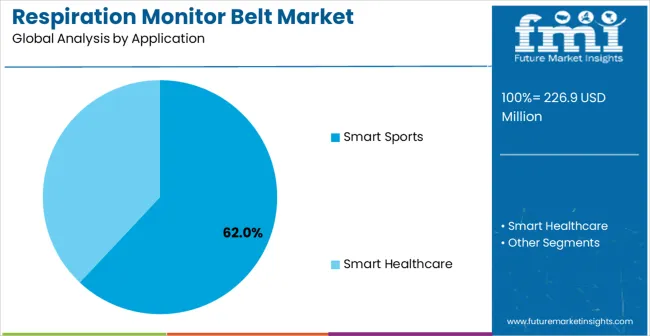
Smart healthcare applications are expected to represent 62% of respiration monitor belt demand in 2025. This dominant share reflects the critical importance of respiratory monitoring in modern healthcare delivery and the need for continuous physiological assessment systems capable of supporting clinical decision making, chronic disease management, and preventive care initiatives. Healthcare organizations require advanced and reliable monitoring systems for patient care, remote monitoring, telemedicine, and clinical research applications across diverse medical specialties including pulmonology, cardiology, and sleep medicine. The segment benefits from ongoing digital health transformation and increasing healthcare focus on patient-centered care and outcome improvement.
Smart healthcare applications demand exceptional monitoring performance to ensure accurate respiratory assessment, early detection of health changes, and comprehensive integration with electronic health records and clinical workflow systems. These applications require monitoring systems capable of providing validated clinical accuracy, regulatory compliance, and seamless data integration while maintaining patient comfort and monitoring compliance across diverse healthcare environments. The growing focus on value-based healthcare, particularly in chronic disease management and preventive care programs, drives consistent demand for advanced respiratory monitoring solutions.
The respiration monitor belt market is advancing rapidly due to increasing health consciousness and growing recognition of respiratory monitoring importance in preventive healthcare and disease management. The market faces challenges including device accuracy validation requirements for clinical applications, need for regulatory compliance across different healthcare markets, and varying user acceptance factors affecting long-term monitoring compliance. Standardization efforts and certification programs continue to influence device quality and market development patterns.
The growing deployment of artificial intelligence algorithms and machine learning platforms is enabling advanced respiratory pattern analysis and predictive health assessment capabilities in wearable monitoring systems. AI-powered analytics and cloud-based processing systems provide continuous health monitoring optimization while enabling early detection of respiratory abnormalities and automated clinical alert generation based on personalized health baselines. These technologies are particularly valuable for chronic disease management and preventive healthcare applications that require sophisticated pattern recognition and predictive assessment capabilities.
Modern monitor manufacturers are incorporating multi-sensor technologies and comprehensive health ecosystem integration that enables simultaneous monitoring of respiratory rate, heart rate variability, activity levels, and sleep quality while providing unified health assessment platforms. Integration of advanced biosensors, environmental monitoring, and comprehensive data analytics enables significant enhancement in overall health monitoring effectiveness and clinical utility compared to single-parameter monitoring solutions. Advanced sensor fusion and intelligent health assessment also support development of more comprehensive and actionable health monitoring solutions for modern healthcare applications.
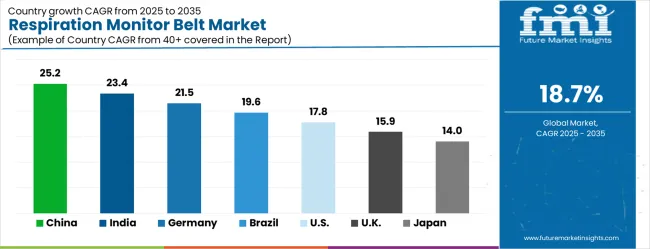
| Country | CAGR (2025–2035) |
|---|---|
| China | 25.2% |
| India | 23.4% |
| Germany | 21.5% |
| Brazil | 19.6% |
| United States | 17.8% |
| United Kingdom | 15.9% |
| Japan | 14.0% |
The respiration monitor belt market is growing rapidly, with China leading at a 25.2% CAGR through 2035, driven by massive healthcare digitization initiatives, expanding middle-class health awareness, and comprehensive government support for wearable health technology adoption across urban and rural populations. India follows at 23.4%, supported by rapid healthcare infrastructure expansion, increasing chronic disease prevalence, and growing investments in digital health technologies supporting accessible healthcare delivery. Germany records strong growth at 21.5%, emphasizing precision healthcare monitoring, advanced medical technology integration, and comprehensive healthcare system digitization supporting patient-centered care. Brazil grows steadily at 19.6%, integrating wearable health technologies into expanding healthcare access programs and growing wellness market adoption. The United States shows robust growth at 17.8%, focusing on chronic disease management, telemedicine expansion, and consumer health technology adoption. The United Kingdom maintains strong expansion at 15.9%, supported by healthcare system modernization and preventive care initiatives. Japan demonstrates solid growth at 14.0%, emphasizing aging population healthcare needs and technological innovation.
The report covers an in-depth analysis of 40+ countries, Top-performing countries are highlighted below.
China is expected to expand at a CAGR of 25.2% from 2025 to 2035, significantly above the global average, driven by rising demand for wearable healthcare devices and home monitoring solutions. Respiratory monitor belts are being adopted in hospitals, clinics, and home-care setups for continuous monitoring of breathing patterns, sleep apnea, and respiratory disorders. Manufacturers are focusing on lightweight, comfortable designs with wireless connectivity, high-accuracy sensors, and real-time data analytics. Companies such as Mindray and Biolight are enhancing production and integrating AI-based features for predictive healthcare. Increasing awareness of chronic respiratory conditions, rising telemedicine adoption, and government healthcare initiatives are further accelerating market growth.
India is anticipated to grow at a CAGR of 23.4% from 2025 to 2035, driven by increasing prevalence of respiratory diseases, rising adoption of wearable health devices, and expanding home-care healthcare infrastructure. Respiration monitor belts are widely used for real-time monitoring of sleep apnea, chronic obstructive pulmonary disease, and hospital patient care. Manufacturers focus on cost-effective, durable, and wireless-enabled devices suitable for diverse Indian conditions. Companies such as HealthSense and Dr Trust are enhancing production capacity and incorporating smart analytics and mobile connectivity. Growth is further encouraged by government initiatives in digital health, telemedicine, and preventive care programs targeting chronic respiratory disorders.
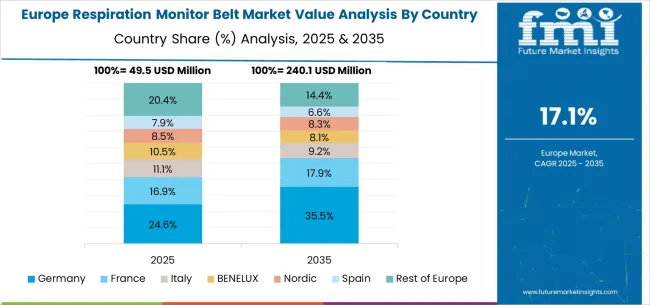
Germany is expected to grow at a CAGR of 21.5% from 2025 to 2035, supported by advanced healthcare infrastructure, growing elderly population, and rising adoption of remote patient monitoring systems. Respiration monitor belts are used in hospitals, sleep labs, and home care to track breathing patterns, sleep quality, and respiratory disorders. Manufacturers focus on high-accuracy, lightweight, and comfortable devices with integrated wireless and IoT capabilities. Companies such as Philips Healthcare and Drägerwerk are developing AI-assisted features for predictive respiratory monitoring and data analytics. Market adoption is also driven by stringent healthcare standards, increasing telemedicine services, and integration with electronic health record systems.
Brazil is expected to grow at a CAGR of 19.6% from 2025 to 2035, influenced by increasing prevalence of respiratory disorders, growing telemedicine adoption, and expansion of home-care health services. Respiration monitor belts are increasingly used in clinical and home settings for continuous monitoring of patients with sleep apnea, COPD, and other respiratory conditions. Manufacturers focus on wireless, easy-to-use, and reliable devices capable of functioning in humid and tropical climates. Companies such as MV Medical and TecnoCare are introducing affordable, connected devices with mobile application support. Government initiatives to improve remote healthcare access and awareness programs are further driving adoption.
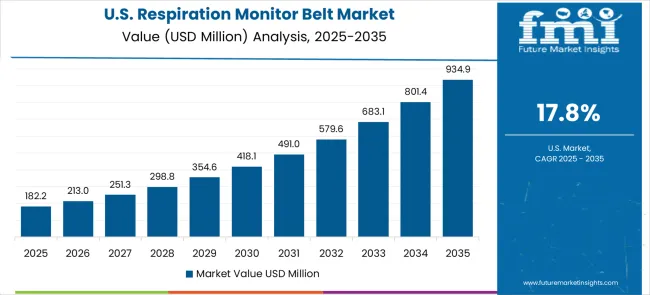
The United States is expected to grow at a CAGR of 17.8% from 2025 to 2035, supported by rising prevalence of respiratory diseases, expanding home healthcare, and increasing telemedicine adoption. Respiration monitor belts are used in hospitals, clinics, and remote monitoring systems for real-time assessment of breathing patterns and sleep-related respiratory disorders. Manufacturers focus on high-accuracy sensors, lightweight designs, and connectivity with mobile apps and electronic health records. Key players such as Masimo and Nonin Medical are developing devices with advanced analytics, predictive monitoring, and cloud integration. Growth is further driven by patient preference for home-based monitoring and government initiatives for digital health solutions.
The United Kingdom is expected to grow at a CAGR of 15.9% from 2025 to 2035, driven by increasing adoption of wearable healthcare devices, telemedicine services, and chronic respiratory care. Respiration monitor belts are used in hospitals, home care, and sleep labs to track respiratory patterns and detect sleep apnea and other disorders. Manufacturers focus on lightweight, wireless, and comfortable designs with integrated AI analytics for predictive monitoring. Companies such as Medtronic and Philips Healthcare are expanding their product lines and incorporating smart mobile app connectivity. National healthcare initiatives and increasing awareness of respiratory health are supporting market growth.
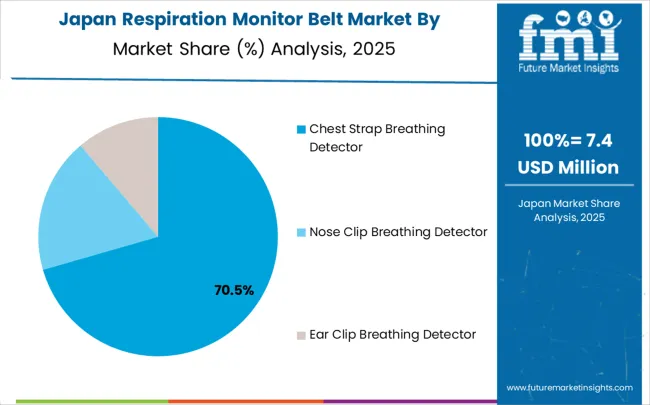
Japan is expected to grow at a CAGR of 14.0% from 2025 to 2035, reflecting steady adoption in clinical, home-care, and wearable healthcare applications. Respiration monitor belts are widely used for sleep apnea detection, chronic respiratory disease management, and hospital monitoring. Manufacturers focus on compact, lightweight, and high-accuracy devices with wireless connectivity and mobile integration. Companies such as Nihon Kohden and Omron Healthcare are developing advanced solutions with predictive analytics and real-time reporting capabilities. Market adoption is influenced by the aging population, high healthcare standards, and preference for home-based monitoring and telemedicine services.
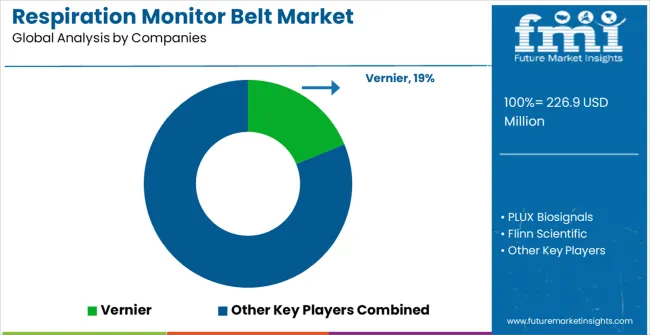
The respiration monitor belt market is defined by competition among established medical device manufacturers, specialized wearable technology companies, and emerging digital health solution providers. Companies are investing in advanced sensor technologies, mobile application development, cloud-based analytics platforms, and regulatory compliance capabilities to deliver accurate, user-friendly, and clinically validated monitoring solutions. Strategic partnerships, technological advancement, and geographic expansion are central to strengthening product portfolios and market presence.
Vernier, operating globally in educational technology, offers comprehensive physiological monitoring solutions with focus on scientific accuracy, educational applications, and technical support excellence. PLUX Biosignals, specialized biosignal monitoring company, provides advanced wearable monitoring systems with focus on research applications and clinical validation. Flinn Scientific delivers educational health monitoring equipment with focus on laboratory and teaching applications. Adinstruments offers comprehensive physiological monitoring solutions with focus on research and clinical applications.
iMotions provides integrated biosensor platforms with focus on human behavior research and physiological assessment. GE HealthCare delivers comprehensive medical monitoring technologies with focus on clinical applications and healthcare system integration. Nihon Kohden offers advanced medical monitoring systems with focus on clinical accuracy and hospital applications. OMRON provides consumer and professional health monitoring devices with focus on home healthcare and clinical validation.
Global ResMed, Brain Vision, Philips Healthcare, Winsensor, Merryteksensor, Resvent, Aqara, and Elas Tech offer specialized respiratory monitoring expertise, regional manufacturing capabilities, and technical support across diverse healthcare and consumer markets.
The respiration monitor belt market underpins healthcare quality improvement, chronic disease management advancement, preventive care enhancement, and population health optimization. With healthcare digitization trends, increasing health awareness, and demand for continuous physiological monitoring, the sector must balance clinical accuracy, user experience, and cost accessibility. Coordinated contributions from governments, healthcare organizations, technology providers, clinical researchers, and investors will accelerate the transition toward intelligent, connected, and highly accurate respiratory monitoring systems.
| Item | Value |
|---|---|
| Quantitative Units | USD 226.9 million |
| Detector Type | Chest Strap Breathing Detector, Nose Clip Breathing Detector, Ear Clip Breathing Detector |
| Application | Smart Sports, Smart Healthcare |
| Regions Covered | North America, Europe, East Asia, South Asia & Pacific, Latin America, Middle East & Africa |
| Country Covered | United States, Germany, India, China, United Kingdom, Japan, Brazil, and other 40+ countries |
| Key Companies Profiled | Vernier, PLUX Biosignals, Flinn Scientific, Adinstruments, iMotions, GE HealthCare, Nihon Kohden, OMRON, Global ResMed, Brain Vision, Philips Healthcare, Winsensor, Merryteksensor, Resvent, Aqara, Elas Tech |
| Additional Attributes | Dollar sales by detector type and application, regional demand trends across North America, Europe, and Asia-Pacific, competitive landscape with established medical device manufacturers and emerging wearable technology specialists, deployment preferences for chest strap versus nose clip and ear clip detector configurations, integration with healthcare systems and mobile health platforms, innovations in sensor technology and wireless connectivity for enhanced accuracy and user experience, and adoption of AI-powered respiratory analysis with cloud-based monitoring and predictive health assessment capabilities for improved clinical outcomes and preventive care effectiveness. |
The global respiration monitor belt market is estimated to be valued at USD 226.9 million in 2025.
The market size for the respiration monitor belt market is projected to reach USD 1,260.1 million by 2035.
The respiration monitor belt market is expected to grow at a 18.7% CAGR between 2025 and 2035.
The key product types in respiration monitor belt market are chest strap breathing detector, nose clip breathing detector and ear clip breathing detector.
In terms of application, smart sports segment to command 62.0% share in the respiration monitor belt market in 2025.






Our Research Products

The "Full Research Suite" delivers actionable market intel, deep dives on markets or technologies, so clients act faster, cut risk, and unlock growth.

The Leaderboard benchmarks and ranks top vendors, classifying them as Established Leaders, Leading Challengers, or Disruptors & Challengers.

Locates where complements amplify value and substitutes erode it, forecasting net impact by horizon

We deliver granular, decision-grade intel: market sizing, 5-year forecasts, pricing, adoption, usage, revenue, and operational KPIs—plus competitor tracking, regulation, and value chains—across 60 countries broadly.

Spot the shifts before they hit your P&L. We track inflection points, adoption curves, pricing moves, and ecosystem plays to show where demand is heading, why it is changing, and what to do next across high-growth markets and disruptive tech

Real-time reads of user behavior. We track shifting priorities, perceptions of today’s and next-gen services, and provider experience, then pace how fast tech moves from trial to adoption, blending buyer, consumer, and channel inputs with social signals (#WhySwitch, #UX).

Partner with our analyst team to build a custom report designed around your business priorities. From analysing market trends to assessing competitors or crafting bespoke datasets, we tailor insights to your needs.
Supplier Intelligence
Discovery & Profiling
Capacity & Footprint
Performance & Risk
Compliance & Governance
Commercial Readiness
Who Supplies Whom
Scorecards & Shortlists
Playbooks & Docs
Category Intelligence
Definition & Scope
Demand & Use Cases
Cost Drivers
Market Structure
Supply Chain Map
Trade & Policy
Operating Norms
Deliverables
Buyer Intelligence
Account Basics
Spend & Scope
Procurement Model
Vendor Requirements
Terms & Policies
Entry Strategy
Pain Points & Triggers
Outputs
Pricing Analysis
Benchmarks
Trends
Should-Cost
Indexation
Landed Cost
Commercial Terms
Deliverables
Brand Analysis
Positioning & Value Prop
Share & Presence
Customer Evidence
Go-to-Market
Digital & Reputation
Compliance & Trust
KPIs & Gaps
Outputs
Full Research Suite comprises of:
Market outlook & trends analysis
Interviews & case studies
Strategic recommendations
Vendor profiles & capabilities analysis
5-year forecasts
8 regions and 60+ country-level data splits
Market segment data splits
12 months of continuous data updates
DELIVERED AS:
PDF EXCEL ONLINE
Acoustic Respiration Sensors Market Outlook 2025 to 2035
Monitoring Tool Market Size and Share Forecast Outlook 2025 to 2035
Pet Monitoring Camera Market Size and Share Forecast Outlook 2025 to 2035
Brix Monitor Market Size and Share Forecast Outlook 2025 to 2035
Pain Monitoring Devices Market Size and Share Forecast Outlook 2025 to 2035
Dose Monitoring Devices Market - Growth & Demand 2025 to 2035
Brain Monitoring Market Size and Share Forecast Outlook 2025 to 2035
Motor Monitoring Market Size and Share Forecast Outlook 2025 to 2035
Neuro-monitoring System Market Size and Share Forecast Outlook 2025 to 2035
Media Monitoring Tools Market Size and Share Forecast Outlook 2025 to 2035
Noise Monitoring Devices Market Size and Share Forecast Outlook 2025 to 2035
Nerve Monitoring Devices Market Insights - Growth & Forecast 2025 to 2035
Yield Monitor Market Growth – Trends & Forecast 2025 to 2035
Power Monitoring Market Report - Growth, Demand & Forecast 2025 to 2035
Urine Monitoring Systems Market Analysis - Size, Trends & Forecast 2025 to 2035
Brain Monitoring Systems Market is segmented by Lateral Flow Readers and Kits and Reagents from 2025 to 2035
Flare Monitoring Market
Yield Monitoring Systems Market
In-Ear Monitors (IEMs) Market Analysis - Size, Share, and Forecast 2025 to 2035
Driver Monitoring System Market Growth - Trends & Forecast 2025 to 2035

Thank you!
You will receive an email from our Business Development Manager. Please be sure to check your SPAM/JUNK folder too.
Chat With
MaRIA